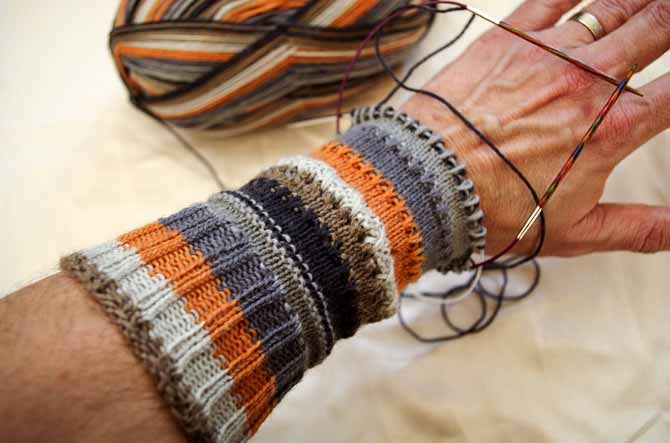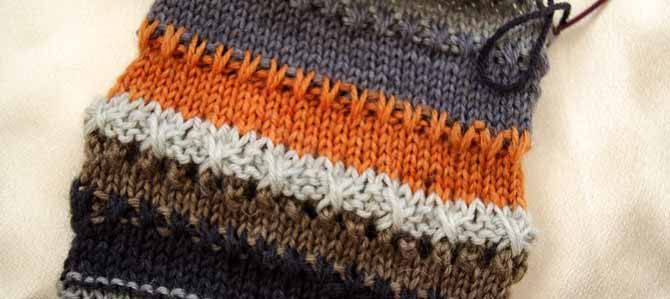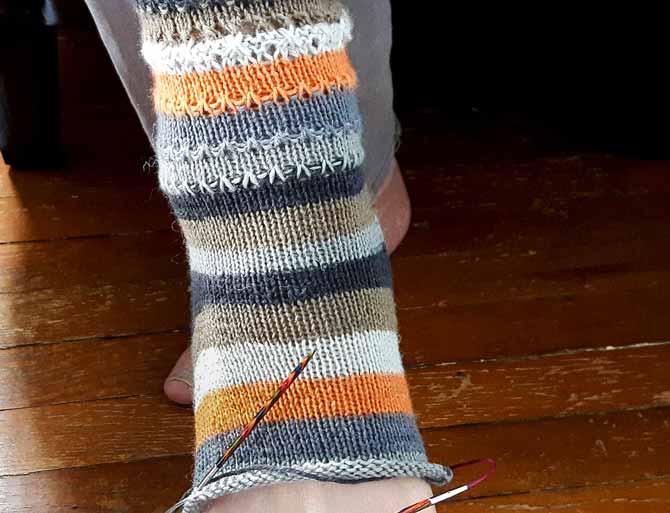This week, I’m knitting cuff-down socks with Wisdom Yarns’ Prose. Yesterday I summed up 7 great sites with lots of information about toe-up socks, and today I’m looking at cuff-down socks and blurring the boundaries between stripes.

Prose would work as a wrist warmer or for mittens and gloves as well as for socks. I’m just sparing you from seeing my toes.
I’m wearing this sock on my arm; suffice it to say, I’m not a foot model. In these cuff-down socks, I’m trying to smudge the edges between the stripes with different techniques. The first one was to use purl rounds to create garter stitch ridges right where the yarn changed color. I’m not impressed. You can see the ridges between the first light gray stripe and the dark gray stripe. Just looks like the wrong side of a new color join.

I tried several ways to blend the edges of the stripes. The first was to use purl rounds to create garter stitch ridges.
Then I tried to work a fancy cross over tuck stitch into lace eyelets over garter stitch ridges.

I worked tuck stitches into yarn-over eyelets created several rounds earlier. (light gray stripe)
This is kind of cute, but the crossed tuck stitches were supposed to be in the orange and cross over the light gray into the eyelets. This didn’t work for me, partially because the light gray stripe was too narrow—one more garter stitch ridge may have done the trick—partially because I started the eyelet row too early. The other reason I didn’t like this approach was that it really leaves a raised bumpy ridge around the sock. These will end up frogged or adopted by my wife Pam, because she likes the textural changes.
Finally, the technique that I find works well and is closest to what I’m looking for are the lengthened slip stitches that I stretch over the garter stitch ridge. To do this, I knit stockinette rounds up to the point where I have enough yarn to make only one more round, then I work the following on an even number of stitches: *K1, knit 1 but wrap yarn twice; repeat from * around.
For the next round, I purl each knit stitch and for the double wrapped stitches, I slip them purlwise but with the yarn in back. This happens for two rounds.
Then I knit the fourth round. This pulls the slipped double wrapped stitches up across 3 rounds and extends the first color across the ridges of the new color. It’s a fun and easy effect.
But when I got to the heel, I decided to stop the blending for two reasons. First, the texture was actually annoying to me. I was that kid who hated store-bought socks when they had that ridge of thread right by the toes, if you know what I mean. Second, with the widening of the instep and the short rows, the striping became less predictable.

This is a heel knit with a double series of German short rows.
Things I will and won’t do again in cuff-down socks…
I won’t use German short rows for the heel and while I like them because they’re invisible for single ridges of short rows, I don’t like them when you need to have one ridge of short row turns immediately after the first to give the 90-degree change in the orientation of the sock.
I’ll read the advice on short row heels from yesterday’s round-up again and try something else next time.
I also have a high instep, so I usually increase a few stitches on the underside of the foot which gives a wider circumference for the gusset but doesn’t interfere with the neat decrease line created by paired gusset decreases; I’ll do this again.

Here’s a great tip for socks headed to a wearer with a high instep: hide a few increases under the heel to allow the sock to rise up over the instep. Four or (in this case) six stitches will give the wearer just the right amount of ease to slip that sock on and off without a struggle!
I lost 3 colors in the stripe sequence with this monster short-row heel. I recently watched a video podcast by Sockmatician (Episode 42b) and he discussed how he winds off a small amount of yarn to use for the heel so that the stripe sequence from the cuff through the instep and down the gusset and towards the toes is never interrupted. Unfortunately, I saw that episode too late and ended up with this, but I’ll try this next time.

3 of the colors in the stripe sequence are missing because of the heel. There is a solution to this though, winding off a small amount of the same colors that would appear in the heel and use them to knit the heel so that when you resume the rest of the stitches, you still have those colors of stripes on stand-by.
Lastly, I did learn that I like the old Norwegian cast on or the twisted German cast on (it has several other names) for a really stretchy edge to my ribbing that easily gets past my instep and monster heel. So if I EVER knit a cuff-down sock again, I’ll definitely use it. For now, I’ll adopt it for any other item I knit in the round that starts with a band of ribbing.
Tomorrow, I’ll look at a completely different application for Prose yarn as we leave socks behind and explore dropped stitch lace.
This is part 3 of 5 in this series.
Go back to part 2: 7 go-to recipes for successful toe-up socks
Go to part 4: How dropped stitches create a knitted lace pattern – surprisingly beautiful

1 comment
the messed stripes is why my stripes end with the division for heel prep. solid feet on my socks shhh!and same with patterns too, I happen to love smooth feet